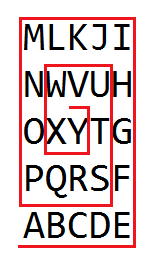22
1
Consider a square block of text, N characters wide by N tall, for some odd integer N greater than 1.
As an example let N = 5 and the text be:
MLKJI
NWVUH
OXYTG
PQRSF
ABCDE
Notice that this is the alphabet (besides Z) spiraled around counter-clockwise from the lower left corner. It's kind of like a rolled up carpet.

"Unrolling" the text by one quarter turn clockwise so FGHI are on the same level as ABCDE results in:
PONM
QXWL
RYVK
STUJ
ABCDEFGHI
This unrolling can be done 7 more times until the text is a single line:
SRQP
TYXO
UVWN
ABCDEFGHIJKLM
UTS
VYR
WXQ
ABCDEFGHIJKLMNOP
WVU
XYT
ABCDEFGHIJKLMNOPQRS
XW
YV
ABCDEFGHIJKLMNOPQRSTU
YX
ABCDEFGHIJKLMNOPQRSTUVW
Y
ABCDEFGHIJKLMNOPQRSTUVWX
ABCDEFGHIJKLMNOPQRSTUVWXY
Challenge
The challenge is to write a program that is an N×N block of text that outputs the number of times it has "unrolled" by a quarter turn when it is rearranged into the unrolling patterns and run.
There are really two contests here: (hopefully it won't be too messy)
- Do this with the smallest N. (down to a limit of N = 3)
- Do this with the largest N. (no limit)
There will not be an accepted answer but the winner in each of these categories will receive at least 50 bounty rep from me. In case of ties the oldest answers win.
Example
If your code block is
MyP
rog
ram
running it as is should output 0.
Running
rM
oy
ramgP
should output 1.
Running
or
ramgPyM
should output 2.
Running
o
ramgPyMr
should output 3.
Finally, running ramgPyMro should output 4.
Details
- The output should be printed to stdout (or the closest alternative) by itself. There is no input.
- You may only use printable ASCII (hex codes 20 to 7E, that includes space) in your code.
- Spaces fill the empty space in the unrolling arrangements. (Unless you're unrolling to the left.)
- Only the arrangements from completely square to completely flat need to have valid output. No other arrangements will be run.
- You may not read your own source.
- You may use comments.
- N = 1 is excluded since in many languages the program
0would work. If desired you may unroll to the left rather than the right. So e.g.
MyP rog rambecomes
Pg yo Mrramand so on. No extra spaces are added when rolling this way. The lines just end
(Related: Write a Rectangular Program that Outputs the Number of Times it was Rotated)
Before I read the "challenge" paragraph, I was expecting a challenge to write a program that outputs itself unrolled – John Dvorak – 2014-10-18T07:04:14.953
1why does N have to be odd? – John Dvorak – 2014-10-18T07:05:36.600
1@JanDvorak I suppose N didn't have to be odd, but it makes the spirals more standardized. It's staying that way but feel free to post an N = 2 as a comment if you find one. – Calvin's Hobbies – 2014-10-18T07:11:59.160
Do you know if N=3 is possible? – John Dvorak – 2014-10-18T08:18:20.347
8Just an idea: Unrolling the "carpet" to the right creates many lines starting with whitespace, eliminating languages like Python. If you'd allow unrolling to the left, there'd be no need for additional whitespace and Python is (theoretically) possible. – Falko – 2014-10-18T10:27:54.057
@Falko Good point. I'll allow unrolling to the left instead. – Calvin's Hobbies – 2014-10-18T15:32:22.287
5Do you have a magic book with infinite great challenge ideas? How else do you keep coming up with such interesting challenges? – Justin – 2014-10-18T16:55:46.330
@Quincunx Someday when I'm tired of PPCG I'll upload my entire tome ;) (But sadly this particular challenge is already almost totally solved by Jan.) – Calvin's Hobbies – 2014-10-18T17:39:22.033
@JanDvorak I don't know about N = 3. I'm guessing no. – Calvin's Hobbies – 2014-10-18T17:40:00.770
It's the first time I want a language (APL for instance) to have base 10 logarithm by default.
00\n⍟1returns the result timesln(10). – jimmy23013 – 2014-10-19T09:48:21.047